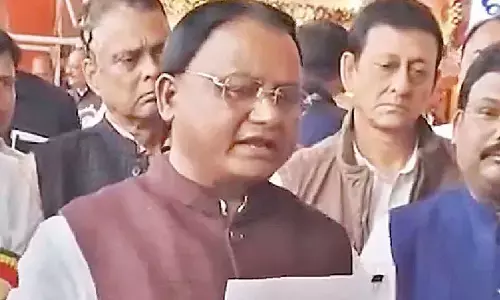Reaping demographic dividend

Economies are not built by natural resources alone. The economies in knowledge-based global societies are increasingly built upon human resources, observed the World Bank report on knowledge-based global societies.
Economies are not built by natural resources alone. The economies in knowledge-based global societies are increasingly built upon human resources, observed the World Bank report on knowledge-based global societies.
Andhra Pradesh Chief Minister N Chandrababu Naidu is, therefore, right on emphasising on harnessing the power of youth to reap demographic dividend. But as the 11th Plan document said India enjoys the demographic dividend with a large working age population. But, it will be a demographic nightmare, if we cannot provide education, nutrition, health and skills. Instead of focusing on strengthening human development, the debate is wrongly focusing on increasing the population. More kids are not just a solution. Healthy, nutritious kids with good quality education and skill are something which we have to focus on. Andhra Pradesh has to come out of its abominably low level of human development instead of just adding to the numbers. Amartya Sen in his comparative analysis of India and China emphasised that the latter‘s success is more due to its pre-reform achievements in social and human development.
The population structure of Andhra Pradesh has both strengths and concerns. The State enjoys the demographic advantage of having a significant proportion of youth in its overall population. According to the census data, about half of the State’s population is below the age of 25 years. The elderly (60 years and above) constitute only eight per cent of state’s population. This potential of the youth can be harnessed to reap the demographic dividend.
The recently released Raghuram Rajan report categorised Andhra Pradesh state as a less developed state with the under development index values at 0.521.
The White Paper on Human Resources and Social Development in Andhra Pradesh said the Human Development Indices (HDI) of Andhra Pradesh have not showed a great progress in terms of relative rankings among the States. In fact, Andhra Pradesh has not even marginally moved up from its position in 2004-05 as it remained at the same rank during 2011-12 HDI rankings.
The Human Development Indices did not improve despite a strong growth performance in the economy. As the white paper observed, it is certainly a missed opportunity. Thus, the State government should now focus on increasing the monthly per capita expenditure, education, health, household amenities, poverty rate, female literacy, financial inclusion and connectivity etc. As per the 2011 Census, Andhra Pradesh with 67.66 literacy rate stands at 31st position out of 35 ranks of States and Union Territories put together. The state is ahead of only Bihar, Arunachal Pradesh, Rajasthan and Jharkhand. Should the State have more children without such basic skills like literacy? The government should focus on improving literacy and educational standards rather than exhorting people to have more children. The governments which fail to provide basic amenities to the people with the existing levels of population cannot condemn the society to having more deprived children.
Literacy in Andhra Pradesh rose by a phenomenal 17.01 per cent points between 1991 and 2001 Censuses, as compared to a rise of 13.17 per cent at the All-India level. Female literacy rose by about 18.47 percent in AP as compared to the All India percentage of 14.87.
In comparison, between the 2001 and 2011 reports of census, female literacy went up by only 8.57 per cent and total literacy went up by even lower 6.55 per cent in Andhra Pradesh, which was much lower than the increase of 11.30 per cent in female literacy and 8.66 percent in total literacy at the national level. In fact, the gap between female literacy percentage of Andhra Pradesh and all India widened in 2011 as compared to 2001.
Therefore, the urgent focus should be on implementing the constitutionally guaranteed right to free and compulsory education and imparting total literacy.
This is the right kind of lesson we have to learn from Japan or China or Korea. Amartya Sen in his comparison of many countries argued that nations with diverse levels of development, demographic characteristic etc., have made significant gains in social or human development. They include China, Cuba, Vietnam, Japan, Korea, Jamaica, Sri Lanka etc. Even states like Kerala have similar lesson to offer. The Andhra Pradesh government should focus on learning from within or abroad, rather than chant the slogan of ‘Beget more kids.’
Andhra Pradesh lags behind many major States in various educational indicators. The aforementioned White Paper itself has clearly pointed out this deficiency in the development of the State. The White Paper observed: “A comparison of performance in terms of major indicators pertaining to the education sector has revealed that not much progress has been made during the last ten years. Gross Enrolment Ratio (GER) in the State, which is a key monitor able indicator specified under the Millennium Development Goals (MDGs), has not kept pace with neighboring southern states. The GER for Andhra Pradesh for classes I-VIII (6-13 years) during 2012-13 is only 80.42 per cent which is much lower than other southern states – Tamil Nadu with 100.25 per cent, Karnataka with 88.67 per cent and Maharashtra with a GER of 92.27 per cent. Dropout rate up to elementary level is high, standing at 19.06 per cent which is against the spirit of Right to Education (RTE) Act. The dropout rate at secondary level is even higher, standing at 24.62 percent.”
The State‘s performance even in crucial health indicators remain a matter of concern. The White Paper further stated, “The rate of decrease in IMR has been very disappointing in the State despite the increase in institutional deliveries. An analysis of IMR shows that most of the deaths among infants occur during the Neonatal period i.e. first four weeks of life (66 percent of total IMR) and more so during the first one week which is referred to as Early Neonatal period (80 percent of Neonatal deaths).”
The nutrition is a basic requirement for the healthy growth of population. But, in Andhra Pradesh, one in every five children is born with a low birth weight of less than 2.5 kg; one in every three children (below five years) is underweight; and two in every three children and adolescent girls are anemic. The prevalence of anemia is also very high among pregnant and lactating mothers. The problem is compounded by the fact that 54.8 per cent of girls are getting married below the age of 18 years.
The United Nations Human Development Report considers sex ratio especially child sex ratio as one of the key indicators of human development. The distorted sex ratio reflects the well-being of girls and women in the society.
Here too, the State needs to do a lot. For instance, the sex ratio among 0-6 years has come down in Andhra Pradesh (13 districts) from 964 in 2001 (Kadapa, Nellore and Chittoor being the lowest ranging from 951 to 954) to 944 in 2011 (Kadapa, Anantapur and Chittoor being the lowest ranging from 918 to 931).
The population policy is not just about the number of children. But, the public policy must focus on a range of social indicators like education, nutrition, sex ratio, mortality rates, etc.
By: Prof K Nageshwar

















